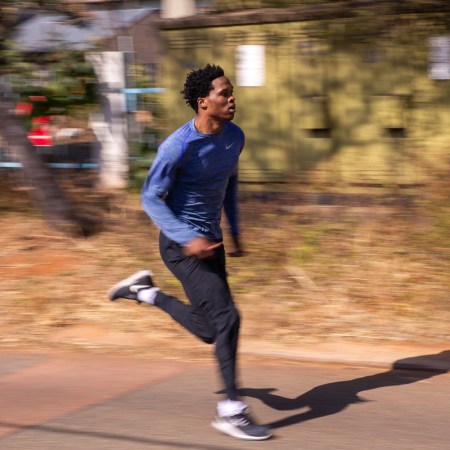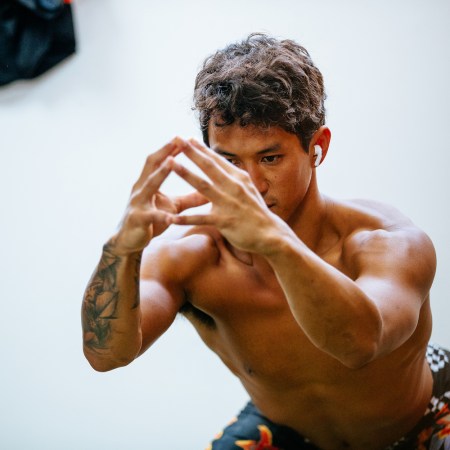There aren’t too many rules at my gym. You have to rerack your weights, wear a shirt and be over the age of 14. Other than that — and the usual capital crimes — pretty much anything is allowed on the open gym floor. That said, during the hour that I usually get my ass over there, the same couple-dozen people are always fighting over the same half-dozen weights and machines.
I’m guilty of it too; I still hustle over to the lat pulldown machine whenever it frees up…even though I’ve been bored of the exercise for months. It’s just easier to stick with what you know when you’re working within a confined timeframe, haven’t done the research on new moves or equipment, and crucially, always, would rather not look like an idiot to the many seasoned grunters around you.
But this is how people plateau on their performance gains, or start ignoring their gym memberships entirely. So here at the precipice of another year of strength training, it’s important to remember that you’re actually allowed to do a whole lot more than what you’ve been doing.
Devon Leveseque (one of the most entertaining fitspo follows on Instagram) said it best in a recent interview with us: “I rarely do the traditional movements like bench, burls or squats, because I have been there and done that. Since I’m going into the gym every day, I make it a goal to try and see what my body is capable of…the first video that I posted on Instagram was me with these two kettlebells. I was just curious if I could jump from yoga ball to yoga ball while holding the kettlebells. I was able to do it in something like five tries.”
Look, that’s obviously insane, and you need as much Evel Knievel in you as Arnold Schwarzenegger to hit the gym with that sort of attitude every single day. But it’s a worthy reminder that your workouts A) deserve your energy and B) are probably due for a bit of ingenuity. One simple, turnkey method for sourcing both involves stacking multiple exercises together to create cohesive “supersets.”
In Leveseque terms, that involves squatting for 12 reps, racking the bar, performing a notorious muscle-up, then returning to the squats. Repeat for six sets. He could just squat for six sets and call it a day, but where’s the fun in that?
And more importantly, where’s the fatigue in that? Sweat is an imperfect barometer of effort in the gym, but it can be a useful one. Consider: for as much as cardio gets your heart rate up and your glands perspiring, how many times have you left a strength training session with sweat on your brow?
Strength Training Your Jaw Is the Latest, Dumbest Craze in Men’s Fitness
What do 4chan, TikTok and Instagram all have in common? Men obsessed with mighty jawlines.In the simplest of terms, “supersetting” involves performing two exercises in a row with minimal (to zero) rest. Conventional weightlifting — of the variety that most trainees at the gym subscribe to, either overtly or subconsciously — involves performing multiple sets of one exercise, with a bit of rest in between. Think: 10 reps, put the weight down, look at your phone, look at yourself in the mirror, don’t make eye contact with anyone, rev yourself up for another 10 reps.
Some lifters stick to this cadence for logistical reasons: they don’t want to lose whatever equipment they’re using to someone else in the gym. Others (the ones who arrive with notebooks and those mini golf pencils) prefer to take their time while moving through the day’s slate. And then there are those who just don’t really know another way; they’ve always lifted one move at a time.
Deploying strategic supersets, though, can give any humdrum lifting regimen the swift kick in the pants it needs. There’s some research out there that minimal rest time helps create more “metabolic demand,” which in turn elicits “musculoskeletal, cardiorespiratory, and physiological adaptations” (gains, baby). Basically: your heart rate is elevated higher and longer than in your usual resistance training sessions; your muscles are forced to do more with less, which helps them build endurance in addition to strength; and your EPOC response (excess post-exercise oxygen consumption) is heightened, too…meaning long after your brow is showered and dry, your body is still burning calories at a prodigious rate.
Assuming all of the science is sound, that’s fantastic. But no one gets into lifting to comb through academic journals; this is one of those situations where some cautious, DIY experimentation will show you firsthand that supersetting, in its many forms, is an energizing/exhausting enterprise (both good things here!), and one you should absolutely save for a rainy day…or at least whenever you catch yourself doing water fountain drive-bys until the bench press is open.
As for how to stitch together a superset, you have some options:
- Go for push-pull: One of our favorite approaches in the gym, push-pull refers to targeting “push” muscle groups/moves during certain sessions in the gym (bench press, parallel dips, skull crushers, etc.) and “pull” muscle groups/moves on other days (bent-over rows, chin-ups, hammer curls, etc.) The cadence is great because it allows you to lift consecutive days in a row, without feeling too fatigued. That’s also why it’s an excellent entry-point for supersets. For instance, trying following a set on shoulder presses with a round of pull-ups. You’re working different groups, and can pack one hell of a wallop into a short workout — this is especially helpful if your week’s work schedule or family obligations appear hectic, and you might not get back to the gym. A few rounds of push-pull supersets should toast your upper half for a few days.
- Target the same muscle: Alternatively, you might just focus on one muscle group. Say summer’s right around the corner, and you’ve read all of our content urging you not to mortgage your mental health/self-perception on the size of your biceps, but you’ve decided you simply don’t give a shit, you’re charging full steam ahead to get show muscles the size of honeydews. In that case, stack exercises that hit the biceps in succession, like cable rope curls into chin-ups, or racked farmer’s carries into renegade rows. (Jokes aside, there are a ton of bicep-minded exercises that can hit the rest of the body in a functional way. Feel free to play with weights, number of reps, rest-time, etc.)
The possibilities don’t end there. Far from it: you can divide the body in half, making a superset that hits both the upper and lower body (keep it simple with a bodyweight cadence, to start — you could do worse than alternating between push-ups and air squats, at 10 repetitions each, for six sets). Or you could mix in cardio (from hopping onto an assault bike for HIIT sprints, to knocking out some jumping jacks). Super-advanced super-setters may even graduate to a honors course known as “cluster sets.”
As always, and especially when attacking a workout that’s built around intensity and efficiency, make sure you don’t stray from proper form and technique. It’s not only possible to fit a better lift into a bite-sized period (say, 15 to 20 minutes; short workouts are deservedly having a moment) without rushing, it’s critical.
Otherwise, you’ll probably get injured. In which case you won’t even get to hit the lat pulldown machine, let alone superset it with box jumps…a superset I concocted the other day. It was random, it was exciting, and I didn’t mind when the machine was taken from me for good. I was on to other matters, anyway.
The Charge will help you move better, think clearer and stay in the game longer. Subscribe to our wellness newsletter today.


















